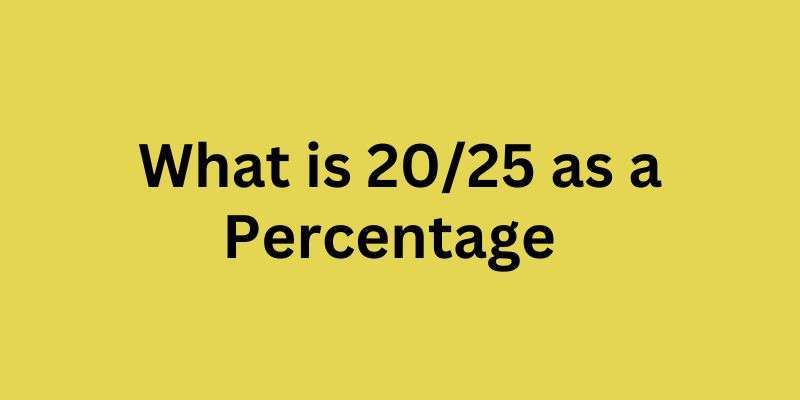In today’s world, where numbers and statistics dominate different parts of our lives, it is vital to understand percentages. Whether you’re managing funds, analyzing data, or simply trying to grasp a concept, percentages play a significant role. One common numerical concept that frequently emerges is the conversion of fractions to percentages. In this article, we’ll dive into the particulars of one such division: 20/25 and its equivalent as a percentage.
Introduction to 20/25 as a Percentage
To understand what 20/25 as a percentage implies, we should separate it. The division 20/25 addresses a piece of an entire where there are twenty sections out of a sum of 25. When switched over completely to a percentage, it uncovers which piece of the entire portion addresses 100 sections.
Understanding Fractions and Percentages
Before delving into the conversion process, having a strong handle of fractions and percentages is fundamental. Fractions address a part of an entire, expressed as a proportion of two numbers: a numerator (the top number) addressing the part and a denominator (the bottom number) addressing the entirety. Percentages, alternatively, are ratios or fractions communicated as parts out of one hundred.
Converting Fractions to Percentages
Converting fractions to percentages includes a direct process. In the first place, you want to decide the same percentage of the portion by duplicating the division by 100. This process yields the percentage representation of the portion.
Explanation of the Conversion Process
While converting fractions to percentages, you’re basically scaling up the division to address it out of 100 sections. This scaling process gives a more clear understanding of the portion’s extent compared with the entirety.
Calculation of 20/25 as a Percentage
Presently, we should apply the conversion process to the division 20/25 to decide its comparable percentage.
Step-by-Step Guide
Multiply the fraction by 100:
20/25×100=80
Determine the percentage:
20/25=80%
Therefore, 20/25 as a percentage is 80%.
Real-World Applications
Understanding percentages, including the conversion of fractions to percentages, has various real-world applications. Whether you’re computing discounts during a deal, deciding the success rate of a project, or breaking down data patterns, percentages are universal.
Importance of Understanding Percentages
Having a strong understanding of percentages enables people to settle on informed choices in different contexts. From financial wanting to academic pursuits, percentages give significant experiences and help in powerful decision-making.
Common Mistakes to Avoid
While ascertaining percentages, it’s fundamental to be cautious and avoid common entanglements. These may incorporate mistaken scaling, the ill-advised position of decimal points, or misconstruing the context of the calculation.
Tips for Quick Percentage Calculations
To smooth out percentage calculations, consider using mental math techniques, like tracking down reciprocals or recognizing designs. Practice and knowledge of common percentages can likewise facilitate calculations.
Further Applications and Scenarios
Percentages track down applications in assorted scenarios, including tax calculations, statistical analysis, and performance evaluations. The capacity to control percentages effectively improves problem-solving skills and analytical thinking.
Importance of Accuracy in Percentage Calculations
Accuracy is central while managing percentages, as even minor mistakes can prompt critical errors. Twofold checking calculations and confirming outcomes add to dependable and reliable results.
Summary
In conclusion, understanding percentages, including the conversion of fractions to percentages, is an essential skill with broad applications. By understanding the concept of percentages and utilizing accurate calculation methods, individuals can navigate different circumstances with certainty and precision.
For insights into the importance of financial literacy, explore our article on THE IMPORTANCE AND BENEFITS OF FINANCIAL LITERACY.

